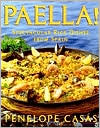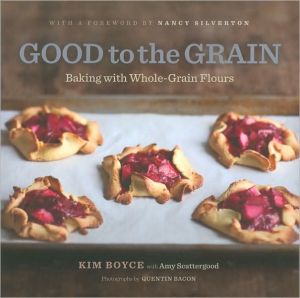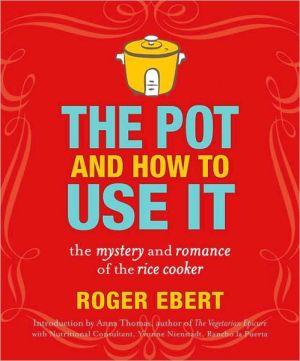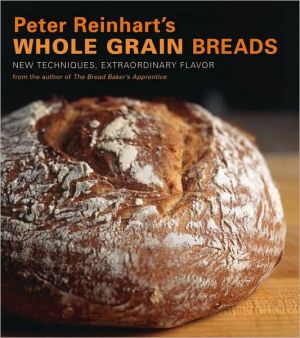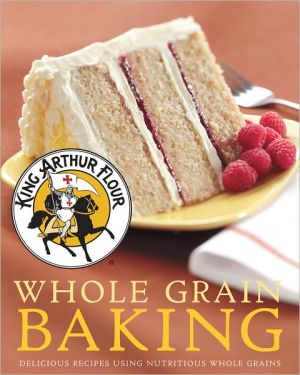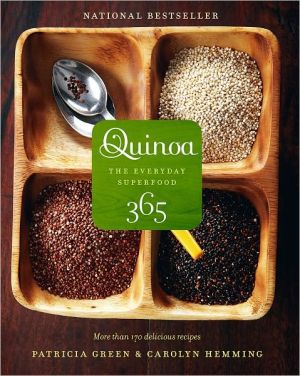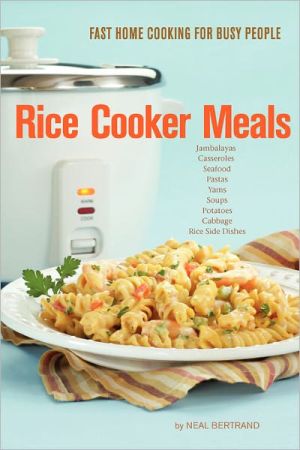Paella!: Spectacular Rice Dishes from Spain
From the best-selling author of Tapas: The Little Dishes of Spain and The Foods and Wines of Spain.\ Unless they have traveled to spain, most Americans have never tasted a really good paella. What passes for paella at restaurants and even in cookbooks here is a pale imitation of the real thing, the vibrant Spanish rice dish that marries the robust flavors of olive oil, garlic, tomatoes, and pepper with short-grain rice, broth, and meat, fish, or vegetables. Penelope Casas is here to restore...
Search in google:
From the best-selling author of Tapas: The Little Dishes of Spain and The Foods and Wines of Spain. Unless they have traveled to spain, most Americans have never tasted a really good paella. What passes for paella at restaurants and even in cookbooks here is a pale imitation of the real thing, the vibrant Spanish rice dish that marries the robust flavors of olive oil, garlic, tomatoes, and pepper with short-grain rice, broth, and meat, fish, or vegetables. Penelope Casas is here to restore the glorious paella to its rightful place as a grain-based meal that will gratify the senses as well as be the centerpiece for easy, elegant entertaining. Casas presents sixty different fascinating paellas, some traditional, some her own creation, showing how easily some of the preparation can be done ahead of time with supermarket ingredients. She includes a superior collection of tapas, the Spanish meal starters, two dozen simple desserts, and a handful of broths and sauces. Her passion for paella, her clear directions, and her creative pairings of fresh ingredients make this unusual cookbook a winner. Library Journal Casas says paella is her passion, and she's determined to show Americans what a "glorious" dish an authentic paella can be. Rather than the usual jumble of shellfish, chicken, and sausage, she prefers versions that feature one particular ingredient. She emphasizes the fact that the rice isn't an afterthought; rather, "the texture and flavor of the rice is everything." She includes recipes for more than 50 different types, from the classic Black Squid Paella ("one of the paella greats") to Vegetable Paella with Spicy Garlic Sauce; there are also recipes for tapas, desserts, and some delicious sauces and dips. Casas is well known for her authoritative books on Spanish food and wine (e.g., Delicioso! The Regional Cooking of Spain, LJ 3/15/96), and most collections will want her latest.
Paella!\ Spectacular Rice Dishes From Spain \ \ By Penelope Casas \ Henry Holt and Co.\ Copyright © 1999 Penelope Casas\ All right reserved.\ ISBN: 9780805056235 \ \ \ Paella!\ A Passion for PaellaValencia: Home of PaellaClearing Up a Few MisconceptionsTips for a Perfect PaellaA Few TricksPairing Spanish Wines with PaellaPaella, among the best known and most beloved dishes in the world, has been my passion ever since I first tasted it in Spain over thirty years ago. And yet I have little enthusiasm for the paellas I have eaten outside of Spain. The horrors that have befallen this exquisite dish and the indignities it has suffered!Paella transforms rice, the sustenance of at least half of the world’s population, into a brilliantly complex and exceedingly baroque creation. Praise for paella comes from all quarters, and paella recipes appear in most allpurpose American cookbooks. Yet even the most respected chefs and cookbook authors have little understanding of how extraordinary paella can be when authentically prepared. They have perpetuated misconceptions that continue to deprive Americans who eat out and cook at home of the true greatness of paella.Paella is not a steamed rice, cooked in a covered pan, but generally a “dry” rice that cooks uncovered in a wide, flat paella pan. It is not bright orange (that comes from artificial coloring), and it is not a precooked pot of Uncle Ben’s rice to which lobster, chicken, and clams have been strewn on top to give a pretty appearance and to disguise what is usually very ordinary rice. Garnishes, in fact, are totally secondary to paella and among their least important features. A paella should never be judged by its toppings; paella is visually striking in itself and needs little additional adornment. The texture and flavor of the rice is everything, and that flavor depends on the ingredients that are combined with the rice and from which the rice soaks up its flavors. Plain rice, after all, is like a painter’s canvas waiting to be transformed into a work of art.For me, the best paella is not the typical mixture of seafood, meat, and sausage that we have come to call paella. Such paellas are frowned upon in Valencia, the area of Spain that is paella’s homeland, because they do not allow each ingredient to be savored and appreciated on its own merits. The best paellas highlight special ingredients—meat, fish, or vegetables. That is why you will find only a handful of so-called mixed paellas in this book.Authentic paella is always made with short-grain rice because it absorbs flavors far more readily than long-grain converted rice (which is parboiled before you buy it) and is immensely more exciting in taste and texture. Serious cooks would not dream of using long-grain rice to make risotto, so why accept it in paella where it is equally inappropriate? The cooking methods and ingredients for paella and risotto may not be the same, but the concept of combining short-grain rice with a variety of ingredients is indeed quite similar.My mission is to rescue the glorious paella that I know and love from worldwide ignominy where it has languished for decades. The time is ripe; interest in grains and in the health-giving Mediterranean diet is at an all-time high. And the Spanish diet in particular, based on the robust flavors of olive oil, garlic, tomatoes, and peppers—all of which enter into paella—has put Spain in the enviable position as the country with the world’s third highest life expectancy. Paella represents just one region of Spain, and each region is a world unto itself. Indeed, Spain compresses the variety of a continent into a country no bigger than Texas. You will find regions of soaring peaks, vast plains, deserts, and thick forests—each with its distinctive culture, a product of many ancient civilizations that passed through the Iberian Peninsula and left their mark.Cooking in Spain is equally varied: extraordinary seafood along the extensive coast; baby lamb and suckling pig, roasted in brick vaulted ovens from the plains of Castile; gazpacho and cooling vinaigrettes from the south, where a strong Moorish influence brought the scents of cumin, coriander, and nutmeg to the cooking; and, of course, paella from the eastern coast, often called the Region of the Rices.Correcting preconceived notions about paella has certainly been an uphill battle, but progress has been made. Some restaurants in America are now preparing paellas in the traditional manner, and my hope is that Paella! will make Americans realize what they have been missing all these years. Curiously, despite its mistreatment, paella’s popularity never fades, no matter what the food fashion of the moment happens to be.Valencia: Home of PaellaA trip to Spain for me is never complete without a visit to paella’s native land, the region on Spain’s eastern coast officially designated País Valencià (Valencian Country), but commonly called El Levante (land of the rising sun, because it is here that Spain greets the day). El Levante also refers to Murcia, the region to the south that also produces and prepares rice. The País Valencià comprises the provinces of Castellón de la Plana, Valencia, and Alicante, and as you head south close to the Mediterranean coast, you will discover the region’s special beauty: In the narrow corridor between the rugged imposing mountains to the west and the sea, the mighty rivers Júcar and Turia deposit rich alluvial soil, forming pancake-flat land. In this warm, humid, sun-drenched area, everything thrives, creating what is often called the Garden of Spain. Orange trees beyond number carpet the land in the province of Castellón de la Plana; farther south as you approach Valencia, small family plots (huertas), which produce the glistening fresh vegetables that are important to every paella, begin to appear. Once past the city of Valencia, vast rice fields dominate the landscape, creating a veritable carpet of bright green rice shoots in summer that competes in beauty with the nearby deep blue Mediterranean.In the rice fields, stooped laborers shaded from the sun by wide-brimmed straw hats plod the marshy land, and whitewashed, straw-thatched workers’ cottages (barracas) dot the rice paddies. The immense lagoon of La Albufera (“little sea” in the Arab tongue) forms the nexus between the swampy rice fields and the Mediterranean; crude, single-sailed sampanlike boats ply the water that is alive with eels, jumping fish, croaking frogs, and aquatic birds. Few sights in Spain rival the splendor and tranquility of a sunset over La Albufera. The Albufera and the rice fields always cast a spell on me; it’s as if I have left Spain and entered some magical, exotic land.The bounty of El Levante, showcased at Valencia’s enormous central market, would not have been possible without the ingenuity of the Moors, who arrived from North Africa almost thirteen hundred years ago. They created elaborate irrigation systems to channel river water from the mountains that otherwise would be lost to the sea. To this day a water tribunal composed of town elders meets every Thursday morning on the steps of Valencia’s cathedral to settle water disputes, and although they are not backed by any legal authority, their decisions are ironclad; there is no higher court of appeal. The Moors also introduced rice, known by its Moorish name, arroz, to the region, as well as saffron (an Arab word that refers to the yellow color saffron gives). All this set the scene for the creation of paella several centuries later. Many paellas are in fact called arroz con (rice with) followed by the names of the key ingredients.Paella bestows an aura on the Valencia region, for it is not merely a regional food specialty but part of the very fiber of Valencian life. It is a diet staple, eaten daily, usually for lunch, the main meal of the day, and occasionally for dinner (Valencians consume more than fifty pounds of rice per person each year). Depending on what is combined with the rice, paella can be a poor man’s meal or a deluxe extravaganza.Paella in Valencia simply cannot be surpassed. Although the region’s water is not among the tastiest to drink (and just try to rinse the suds from your hair with it), when it is used to cook the rice (or to make broth for the rice), it contributes to a perfect paella. Then there is the rice itself, local varieties that are short grained and low in starch. Particularly outstanding is arroz bomba, a relatively rare rice used by some of the best restaurants, which expands like an accordion when cooked and is unique in texture (to obtain it, see Sources, page 215).The region’s long tradition of preparing rice has made every Valencian a master of paella. Men who wouldn’t dream of entering the kitchen are often in charge of an outdoor paella. There are also authentic paella maestros, known in the region for their superlative skills. These chefs often take their shows on the road, organizing paella fests for hundreds (even thousands), and the entire meal is made in a single paella pan. The Guinness Book of World Records lists a paella for fifty thousand people made with ten thousand pounds of rice in a paella pan sixty feet across. Although I did not witness that event, I was present for a paella made for five hundred by my friend Ximo and his son Nacho from La Tasca del Puerto restaurant. Organized in a remote setting in the mountains west of Castellon de la Plana, it was a lively outdoor summer affair. As impossible as it may seem, the paella was cooked to perfection.So many of my fondest remembrances of Spain are connected to paella, and I am still sometimes surprised at the lengths to which my husband, Luis, and I will go to eat our favorite paellas. We once drove like demons to reach La Tasca del Puerto, portside in Castellón de la Plana, before dining hours were over because we craved the restaurant’s sensational Black Squid Rice. On another occasion we braved a torrential downpour that threatened to engulf our car because we didn’t want to miss tasting a few of the fifty different paellas on the menu each day at La Dársena in Alicante. We sat impatiently in a colossal traffic jam between Valencia and Denia, never considering turning back, for the exquisite pleasure of eating El Pegolí’s one and only paella, Arroz a Banda. When we travel to Valencia, we never pass up eating a paella outdoors at Racó d’Olla while the sun sets over the Albufera lagoon. And we always take a ride to the city’s beach near the port to pay our respects to ninety-year-old Juanita, owner of the venerable La Pepica restaurant, paella mecca of the world and once a favorite of Ernest Hemingway. There we look forward to a paella made the old-fashioned way—over a wood-burning stove and brought to the table for our approval before serving. Later a dish of socarrat—crisp rice scraped from the bottom of the pan, the crowning jewel of a well-made paella—is presented to us with great pride and ceremony.Although Paella! includes all the traditional paellas I have enjoyed for years in Spain, there are many unconventional ones here as well that do not appear on menus in Spain, in Spanish cookbooks, or at Spanish tables. The revolution in cooking that took Spain by storm in the seventies did not bring change to paella, and I also had limited myself to a handful of tried-and-true paella recipes. For this book, however, I experimented with new combinations, always based on Spanish ingredients and sometimes on traditional dishes that do not normally include rice. It was a venture that produced some sensational new paellas and I think takes paella to a new dimension. My hope is that you too will find pleasure in exploring paella’s endless possibilities. ¡Buen provecho!Clearing Up a Few MisconceptionsIsn’t paella just one dish? Since I announced my intention to write an entire cookbook on the subject of paella, I have been asked this question time and time again. Paella is most certainly not one dish; it is endless dishes made with almost any ingredient. It is a technique for making many rice dishes that are generally united by the eye-catching paella pan (the word paella comes from the Latin word patella, meaning pan) in which they cook and by their cooking method. The only indispensable ingredients are rice, water, and olive oil. Everything else is the subject of endless debates and discussions by Spaniards, who love a lively discussion and consider their own recipe the one and only. Paellas are as free-spirited as the cooks who prepare them; once the technique is mastered, the sky is the limit. Indeed, after completing Paella! I realized that I had just begun exploring paella’s diversity.Isn’t paella difficult to make? Not at all, and although it makes a splendid party dish (for which most of the preparation can be done in advance), it is just as appropriate for quiet nights at home.Isn’t making paella time-consuming? Paella takes no more time to make than any other meal made from fresh, healthy ingredients. Keep in mind that the entire meal is in the paella pan; there is no need to prepare side courses, and cleanup is minimal. To further simplify a meal based on paella, Paella! includes both appetizers and desserts that are easy, quick, and ideal accompaniments to paella. You can focus your attention on the paella and still have a splendid three-course meal.Doesn’t paella require special equipment and ingredients? While the time-honored paella pan is best for making most paellas, shallow casseroles also work well. It is certainly not necessary to invest in an expensive stainless-steel paella pan. Paella chefs, in fact, are disdainful of them and prefer the traditional thin-metal, wide-bottomed, shallow pans that heat like lightning and immediately adjust to changes in temperature.Most ingredients in a paella are common supermarket items. Even when a few more unusual ingredients are suggested, I have made every effort to offer everyday substitutes.Tips for a Perfect PaellaRecipes may be halved or doubled without any change in ingredient proportions.Have all ingredients chopped and measured before beginning the final cooking of the paella; it is a quick-cooking dish that, not unlike dishes in Chinese cooking, must have all ingredients ready to go. This can be done well in advance, especially when cooking for guests. To cut down on time, have your butcher or fishmonger cut up your meats and fish. Some frozen vegetables, as indicated in the recipes, work as well or better than fresh.Since clams and mussels, when called for, are generally cooked directly in the rice, they must first be purged of grit by soaking them in water. Scrub the mussels or clams and rinse well, then place in a bowl of salted water to cover. Sprinkle with about 1 tablespoon cornmeal, bread crumbs, or flour and refrigerate several hours or overnight. Rinse well before using.Sprinkle other seafood with kosher or sea salt about ten minutes before cooking to help bring back the briny taste of the sea that most seafood, especially frozen seafood, tends to lose.Keep the measured broth very hot but not boiling, before beginning the final cooking. If it boils, some will evaporate, and you will be short of liquid. The success of a paella is directly related to the depth of flavor of its broth. Canned chicken and vegetable broths and bottled clam juice are perfectly acceptable, but, if possible, enhance them as described on page 207 with herbs, onions, and other flavor boosters. Best of all, make your own broths from the recipes in Chapter 8.Ingredients such as nuts, garlic, and parsley are often mashed to a paste in a ceramic or stone mortar or in a miniprocessor to release their full flavor. The mortar (one of civilization’s ancient cooking tools) does a better job and is simpler to use and to clean than a miniprocessor. I would never be without a mortar in the kitchen. Try it.A paella pan is specifically designed to cook paella. Wide, very flat, and with low sides sloping outward, the authentic cheap metal pans (not heavy stainless steel; see Sources, page 215) are still the best to cook the rice so that it is low in moisture and al dente. Even with the best of care these pans will darken and discolor with use, and will rust if left wet. Therefore, after making a paella, rinse with water and remove any scraps with a stiff brush, clean with steel wool soap pads (the pan cleans quite easily), rinse, and dry immediately and thoroughly with paper towels. Let the pan sit a few minutes to continue drying, then apply a light coating of olive oil with a paper towel before storing. You can, however, make a good paella in a stainless-steel paella pan or in any wide, flat-bottomed casserole dish that can go from burner to oven.Sauté your “aromatics” (onion, garlic, peppers, tomato, and so forth) in olive oil as indicated in each recipe. Paprika is an especially important addition to most paellas; do make an effort to buy Spanish smoked paprika, which gives an extraordinary flavor to paella (see Sources, page 215). Another typically Spanish ingredient requisite in several paella recipes are ñoras, dried sweet red peppers (much more common in Spain’s cooking than chile peppers); they give a golden color to the rice and lend their distinctive flavor.Once the rice is added, stir to coat well with the pan mixture so that the rice absorbs the olive oil and is thus sealed, preventing the rice from releasing its starch and keeping it firm.Short-grain rice imported from Spain (see Sources, page 215) gives the most authentic results: firm, dry, and al dente. Unique bomba rice from Valencia is incomparable (but note that this rice requires a little more liquid—about cup more for 3 cups of rice—and may take a few extra minutes to cook). Italian Arborio, although yielding a creamier rice, is more than acceptable. (The Italian rice that I find works particularly well is Beretta Superfino Arborio.)Olive oil is essential to a paella. Make sure it is a good one, but you should not use your best extra-virgin oil (save that for the sauces and dips and for some of the first-course recipes). While you are exploring Spanish paellas, why not also get acquainted with the splendid olive oils from Spain? Their flavor is distinctive, and I consider them the world’s finest.Although all recipes call for saffron, which is either softened in the broth or mashed with other ingredients in a mortar or miniprocessor, it is not essential. I have eaten great paellas even in Valencia that omitted saffron. But if you use saffron, make sure it is genuine, pure saffron from Spain, and buy it from a reputable source. Buy it in threads (not ground) to better judge its color and quality. Saffron is very expensive, but a very small amount goes a long way. If it is stored in a tin or covered glass jar away from light, it will last indefinitely.When you add the hot cooking liquid to the rice, bring it to a boil, stirring occasionally, and continue to boil until the rice is no longer soupy but sufficient liquid remains to continue cooking the rice. This takes about 5 minutes, and when this point has been reached, the bubbles rising from the pan will look slightly thick, most of the rice will appear at the surface, and a spoon will momentarily leave a path exposing the bottom of the pan when pulled through the center of the rice.Electric ovens, even when properly calibrated, seem to cook paella more slowly than gas ovens. For electric ovens, raise the temperature by 50° and increase the cooking time by 5–8 minutes. Transfer the paella to the oven, uncovered, for final cooking. At this stage the rice should never be disturbed by stirring. Although paella may also be completed on top of the stove, the burners are usually not wide enough to provide even heat to all parts of the paella pan. Finishing the paella in the oven is the most foolproof method.Never cook paella until the rice is completely done. If you do, it will be mushy by the time it reaches the table. Remove from the oven when the rice grains are no longer hard but still have more bite than you want and a crust forms around the edge of the pan. Paella must rest five to ten minutes after being removed from the oven, during which time the final cooking takes place.Paella can be prepared in advance, up to and including the addition of the rice, and kept at room temperature for several hours before completion.Some paella recipes call for specific garnishes, but if not, leave the paella as is or garnish with pimiento strips and/or minced parsley. Both are always suitable and give some added color.Socarrat, the crisp rice that sticks to the bottom of the pan, is considered a delicacy. But if paella is not made over a wood-burning fire, you are not likely to achieve a socarrat. Simulate it by placing the completed paella over very high heat until it begins to stick to the pan and turn crisp. Some recipes give instructions for making socarrat, but a socarrat is appropriate with any paella.Always bring the paella to the table in its pan for diners to admire before serving. Traditionally, paella is eaten communally: Everyone sits around the pan and takes the rice directly from the pan with a spoon. Although you are not likely to serve it this way, do leave the paella pan at the center of the table so guests can help themselves to more.A Few TricksIf your paella is almost al dente and ready to be removed from the oven but still seems to have liquid, return it to the top of the stove over high heat, without stirring, until the liquid has evaporated. Then proceed to cover the rice and let it rest.If the paella is dry before the rice is almost al dente, sprinkle with a few tablespoons of water and allow to cook in the oven 2–3 minutes longer.Paella is still delicious the next day, although never quite the same as freshly made paella. To keep leftovers, remove the paella from the paella pan (otherwise a slightly metallic taste may develop) and store in the refrigerator (not in the freezer because freezing changes the consistency of the rice). Paella reheats best in the microwave.Paella cooked over wood or charcoal will attain a subtle smoky flavor, a result of the smoke that circulates around and over the paella pan. An outdoor paella is a little difficult to do because the heat must be strong but not so strong that it burns the rice. Place the paella pan on a grill about 16 inches from the flame. Sauté your ingredients in the paella pan, just as you would on the stove, then cook the rice as directed in any paella recipe. Instead of placing it in the oven, remove from the flame when almost al dente and let sit a few minutes in a warm spot to finish cooking. For better heat control, use a gas barbecue. Better still, purchase a gas ring grill specifically designed for paellas (see Sources, page 215).Pairing Spanish Wines with PaellaWines from Spain are readily available in America, and they are world class. While appropriate with foods of any nation, they are particularly suited to Spanish foods since both spring from the same earth and seem to have a natural affinity for each other.Although many paellas are based on seafood, red wines are nonetheless generally more appropriate because of the complex and assertive flavors found in paella. For delicately flavored paellas, however, such as Scallop and Mushroom Paella, I highly recommend an elegant dry Albariño white wine, such as Martin Códax or Condes de Albarei from the northwest region of Galicia. For relatively light seafood paellas try the outstanding white wines from Rueda in Castile, like Marqués de Riscal, or a Catalan white such as Juvé y Camps Ermita D’Espiells. For more strongly flavored seafood paellas—Black Squid Paella, for example—nothing could be better than a light-bodied Rioja red wine; Viña Cumbrero and Remelluri are two great choices.Poultry, rabbit, game, pork, and lamb paellas also stand up well to red Riojas and to the crisp, highly praised Ribera del Duero reds that are capturing international attention. Try Yllera, Protos, and Pesquera.Sangria, the original wine cooler, a mix of red or white wine with sugar, citric juices, and sparkling water, is a great drink to accompany a beachside paella. Otherwise, Spaniards much prefer to pair paella with a good wine.Spanish sherries—dry sherries as aperitifs, sweet sherries as dessert wines—are discussed in the Tapas and First Courses chapter and in Desserts, respectively.Copyright © 1999 by Penelope Casas\ All rights reserved. \ \ Continues... \ \ \ \ Excerpted from Paella! by Penelope Casas Copyright © 1999 by Penelope Casas. Excerpted by permission.\ All rights reserved. No part of this excerpt may be reproduced or reprinted without permission in writing from the publisher.\ Excerpts are provided by Dial-A-Book Inc. solely for the personal use of visitors to this web site. \ \
\ Library JournalCasas says paella is her passion, and she's determined to show Americans what a "glorious" dish an authentic paella can be. Rather than the usual jumble of shellfish, chicken, and sausage, she prefers versions that feature one particular ingredient. She emphasizes the fact that the rice isn't an afterthought; rather, "the texture and flavor of the rice is everything." She includes recipes for more than 50 different types, from the classic Black Squid Paella ("one of the paella greats") to Vegetable Paella with Spicy Garlic Sauce; there are also recipes for tapas, desserts, and some delicious sauces and dips. Casas is well known for her authoritative books on Spanish food and wine (e.g., Delicioso! The Regional Cooking of Spain, LJ 3/15/96), and most collections will want her latest.\ \
